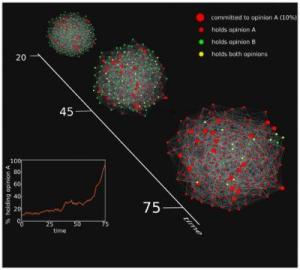This is (further) evidence of how engineers and scientists are smarter than me, but it is an interesting article that talks about how and when minority opinions become majority ones and how inevitable the process is. Just read below:
Minority rules: Scientists discover tipping point for the spread of ideas
Scientists at Rensselaer Polytechnic Institute have found that when just 10 percent of the population holds an unshakable belief, their belief will always be adopted by the majority of the society. The scientists, who are members of the Social Cognitive Networks Academic Research Center (SCNARC) at Rensselaer, used computational and analytical methods to discover the tipping point where a minority belief becomes the majority opinion. The finding has implications for the study and influence of societal interactions ranging from the spread of innovations to the movement of political ideals.
So, when 10% of the population holds an unshakeable belief, that belief will always be adopted by the majority of society. Certainly this finding can apply to complex systems like online networks as well and how memes are passed throughout depending on the participants’ level of trust and conviction. I wonder how they determined the “always become majority opinion” bit, though. There must be some instance in history when a firmly held conviction by more than 10% of the population didn’t become majority opinion? I suppose it would be difficult to determine as historically only 10% or less of the population would have had their opinions recorded at all so it would be difficult to determine a counterpoint. The article is interesting, nonetheless, and a good organizing principle for anyone wanting to shape public opinion. Just like social networks, stick with the vocal, even brash few over the muddled masses.
